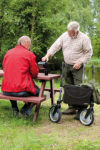
Top tips for buying a rollator, by Katherine Pyne from designed2enable
 A rollator can make a huge positive difference to quality of life, allowing people to maintain – or regain – independence. Continuing to walk around the house and garden, to the shops or to see friends and family, without having to ask for help, is of fundamental value. And improved designs mean rollators are safer and smarter than ever before. There are some great options on the market but a few points need to be considered before purchase.
A rollator can make a huge positive difference to quality of life, allowing people to maintain – or regain – independence. Continuing to walk around the house and garden, to the shops or to see friends and family, without having to ask for help, is of fundamental value. And improved designs mean rollators are safer and smarter than ever before. There are some great options on the market but a few points need to be considered before purchase.
Indoor or outdoor options: Some rollators are suitable for both but a few are designed specifically for outdoor use, such as the TOPRO Olympos. This has large all-terrain wheels to navigate rough ground but is still easy to fold together and transport.
If opting for an indoor rollator, remember that it may need to be narrower to work around spaces in your home such as bathrooms. Let’s Go Indoor is a good example of a slim, lightweight walking aid that is easy to manoeuvre in tight spaces.

The Torpo Olympos Rollator has tyres suitable for indoor use as well as outdoor rough terrain
Brakes: Check whether the rollator has locking/parking brakes. These are safer when you attempt to put pressure on the rollator, as they are designed to keep it firmly in position when you transfer from rollator to chair. It is also safer to have parking brakes when you are on a slight incline or uneven terrain. Driving brakes provide additional safety when walking.
Are the brakes easy to use? If you have limited strength in your hands or only have the use of one hand, some manufacturers supply a one-handed brake.
If you don’t have the reflex to react when braking is required, select a rollator with a reverse brake system.
Folding: For those who enjoy going out by car or on public transport, look for a rollator that folds up easily.
Weight: Make sure that you (or your carer) can comfortably lift the weight of the rollator you choose if you need to store it in the car or lift it onto public transport.
Height: Check that the rollator handles adjust to your suit your height. Having the correct posture when you walk helps prevent injury and aid fitness. The correct handle height should line up with your wrist bone when your arms are hanging loosely by your side.
Maximum user weight: Make sure that the rollator you purchase is suitable for your weight. If your weight exceeds the maximum user weight, it will be unsafe for you.
Seat: Many four-wheeled rollators have an integral seat, which can be helpful if you need to stop and rest. Check that the rollator’s seat is wide enough for your frame.
Back rest: This is usually an optional extra for the four-wheeled rollators. If you need to stop and rest on the seat, the back rest will support you and is a good safety option if you have poor balance, preventing you from toppling backwards.
Storage: With your hands busy steering the rollator, a shopping bag is a handy option and can be used indoors to carry a phone, papers, etc.
Extras: Check what optional extras are available, such as a tray, crutch or cane holder, cup holder, spare shopping bag or travel case.
Wheels: Three- and four-wheeled options have pros and cons.
Three-wheels
Pros: Three-wheeled rollators with the single front wheel tend to be more manoeuvrable than the four-wheeled version and can turn more easily. Having one less wheel makes the rollator lighter and take up less space when folded.
Cons: Having a single central front wheel can make the rollator less stable and for anyone with balance problems who may lean more on one side of the rollator than the other, this may unbalance the rollator, making it unstable. Three-wheeled rollators do not tend to have a built-in seat, which many four-wheeled options provide.
Four wheels
Pros: The extra front wheel provides more stability than the three-wheeled option. The more modern four-wheeled rollators have full rotating wheels for easy manoeuvrability and the rollators tend to come with more additional features and extras.
Cons: Four-wheeled rollators tend to be slightly heavier to lift and may take more space when folded.

Award-winning Rollz Motion converts from rollator to comfortable wheelchair in seconds
Rollator-wheelchair
Alternatively, consider Rollz Motion Rollator, which converts from a wheelchair to a rollator within seconds. And its little sister, Rollz Flex Shopper, is a walker-come-shopper; ideal if you are not quite ready to commit to a rollator.
Style
Buying a rollator that you like and makes you feel good, is important too. If you buy a rollator that you don’t like, you will be less likely to use it. There are some great looking rollators available in a wide range of colours, so be bold and choose something fun that puts a spring back into your step.
Further information
designed2enable is an online retailer that specialises in stylish aids for daily living. Home demonstrations can be arranged for some rollators. Visit www.designed2enable.co.uk or tel 0800 772 3771.
